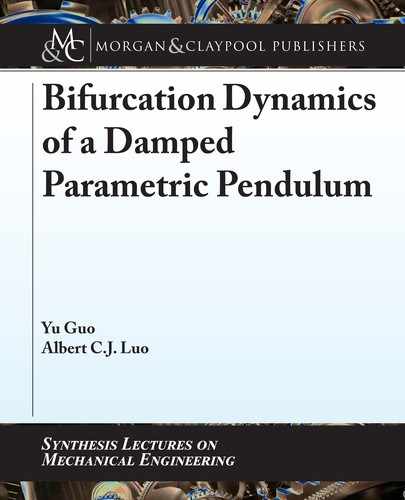5.6. PERIOD-4 MOTIONS 43
there are two paired bifurcation trees, which are symmetric to through the constant term
of a
.m/
0
. e bifurcation trees for the non-travelable period-3 motions are close to 0 or 2.
In Fig. 5.4(ii), the harmonic amplitude of A
1=3
is presented for the non-travelable period-3
motions. e corresponding quantity levels are A
1=3
3:5. e harmonic amplitude A
2=3
is
presented in Fig. 5.4(iii). e quantity levels of such harmonic amplitudes are A
2=3
0:8. e
primary harmonic amplitude A
1
is presented in Fig. 5.4(iv). e corresponding quantity level is
A
1
0:3. e harmonic amplitudes of A
2
and A
9
are presented in Fig. 5.4(v) and (vi), respec-
tively. e quantity levels for non-travelable periodic motions are A
2
0:09 and A
9
10
5
.
For travelable period-3 motion to chaos, the harmonic analysis is based on the corre-
sponding velocity. e constant term a
.m/
0
D (m D 3; 6) of velocity is presented in Fig. 5.5(i)
for the positive branch. For the negative branch of the asymmetric period-3 motion to chaos,
a
.m/
0
D is not presented. In Fig. 5.5(ii), the harmonic amplitude of A
1=6
is presented for
period-6 motions only. For period-3 motions, A
1=6
D 0. e quantity level is A
1=6
0:5. In
Fig. 5.5(iii), harmonic amplitude A
1=3
is presented for period-3 and period-6 motions. e
period-doubling bifurcation from period-3 to period-6 motions can be clearly observed. Such
an asymmetric period-3 motions has a saddle-node bifurcation for onset, and a period-doubling
bifurcation for an asymmetric period-6 motion. e quantity level is A
1=3
3:0. e harmonic
amplitude of A
1=2
is presented in Fig. 5.5(iv) for period-6 motion only. us, A
1=2
D 0 for
period-3 motions, an the quantity level is A
1=2
1:2. In Fig. 5.5(v), the harmonic amplitude of
A
2=3
is presented for period-3 and period-6 motions with the quantity level of A
2=3
1:8. e
harmonic amplitudes A
5=6
is presented in Fig. 5.5(vi), which is also for period-6 motion only.
us, A
5=6
D 0 for period-3 motions, and the quantity level is A
5=6
0:8. To avoid abundant
illustrations, the harmonic amplitudes of A
.2l1/=6
(l D 4; 5; : : :) will not be presented herein. In
Fig. 5.5(vii), the primary harmonic amplitude A
1
is presented for period-3 to period-6 motions.
e quantity level is A
1
1:0. e harmonic amplitudes A
k
(k D 2; 3; : : : ; 5; 9) are presented
in Fig. 5.5(viii)–(xii). e corresponding quantity levels are A
2
0:6, A
3
0:3, A
4
0:05,
and A
5
0:02. For the harmonic amplitude of A
9
, the quantity level is A
9
2:5 10
4
for
2 .2:0; 3:0/. However, A
9
2 .10
8
; 10
6
/ for > 3:0 .
5.6 PERIOD-4 MOTIONS
Period-4 motions also can be non-travelable and travelable, which are independent. Such
period-4 motions are not from period-2 motion through the period-doubling bifurcation. e
bifurcation treed for non-travelable period-4 motions to chaos are presented first through the
displacement, and the travelable period-4 motions to chaos are presented through the velocity.
In Fig. 5.6, the bifurcation trees of harmonic amplitudes are presented from non-travelable
period-3 motions to chaos through the displacement. e constant term a
.m/
0
(m D 4) is pre-
sented in Fig. 5.6(i). e two paired bifurcation trees are symmetric to . e bifurcation trees
for the non-travelable period-4 motions are close to 0 or 2. In Fig. 5.6(ii), the harmonic am-

44 5. HARMONIC FREQUENCY-AMPLITUDE CHARACTERISTICS
(i) (ii)
Ω
Ω
π
π
π
π
(iii) (iv)
ΩΩ
(v) (vi)
ΩΩ
Figure 5.5: Harmonic frequency-amplitude characteristics for bifurcation trees of travelable
period-3 motion to chaos based on velocity: (i) a
.m/
0
(m D 3; 6). (ii)–(vi) A
k=m
(m D 6; k D
1; 2 ; : : : ; 6; 12; : : : ; 30; 54
); Parameters: (
˛
D
4:0
,
ı
D
0:1
,
Q
0
D 5:0, 2 .2:0; 6:0/). (Contin-
ues.)

5.6. PERIOD-4 MOTIONS 45
(vii) (viii)
Ω
Ω
(ix) (x)
Ω
Ω
(xi) (xii)
ΩΩ
Figure 5.5: (Continued.) Harmonic frequency-amplitude characteristics for bifurcation trees
of travelable period-3 motion to chaos based on velocity: (vii)–(xii) A
k=m
(m D 6; k D
1; 2 ; : : : ; 6; 12; : : : ; 30; 54); Parameters: (˛ D 4:0; ı D 0:1; Q
0
D 5:0; 2 .2:0; 6:0/).

46 5. HARMONIC FREQUENCY-AMPLITUDE CHARACTERISTICS
(i) (ii)
Ω
Ω
π
π
π
π
π
(iii) (iv)
ΩΩ
(v) (vi)
Ω
Ω
Figure 5.6: Harmonic frequency-amplitude characteristics for bifurcation trees of non-travelable
period-4 motion to chaos based on displacement: (i) a
.m/
0
(m D 3; 6). (ii)–(vi) A
k=m
(m D 6; k D
1; 2 ; : : : ; 8; 12; 16; 36); Parameters: (˛ D 4:0; ı D 0:1; Q
0
D 5:0; 2 .2:0; 6:0/). (Continues.)

5.6. PERIOD-4 MOTIONS 47
(vii) (viii)
ΩΩ
(ix) (x)
ΩΩ
(xi) (xii)
Ω
Ω
Figure 5.6: (Continued.) Harmonic frequency-amplitude characteristics for bifurcation trees of
non-travelable period-4 motion to chaos based on displacement: (vii)–(xii) A
k=m
(m D 6; k D
1; 2 ; : : : ; 8; 12; 16; 36); Parameters: (˛ D 4:0; ı D 0:1; Q
0
D 5:0; 2 .2:0; 6:0/).
..................Content has been hidden....................
You can't read the all page of ebook, please click here login for view all page.
